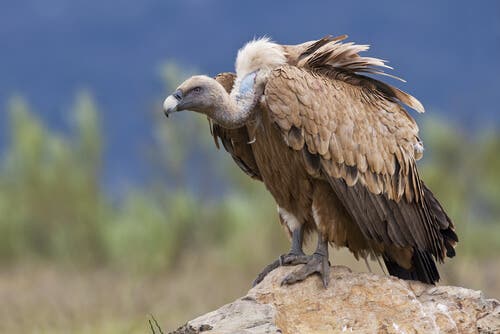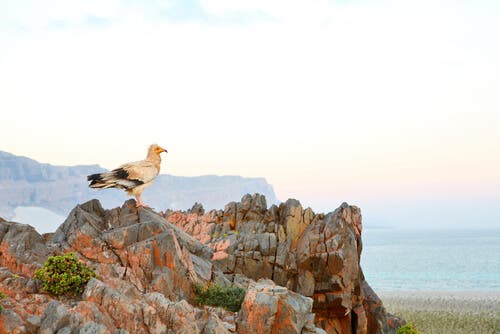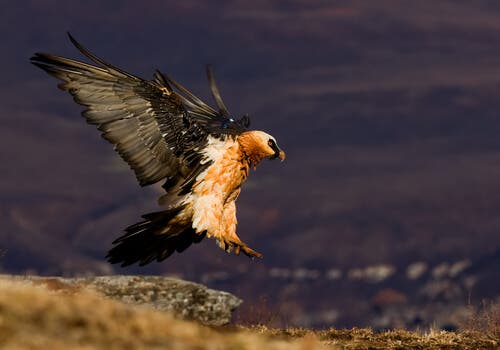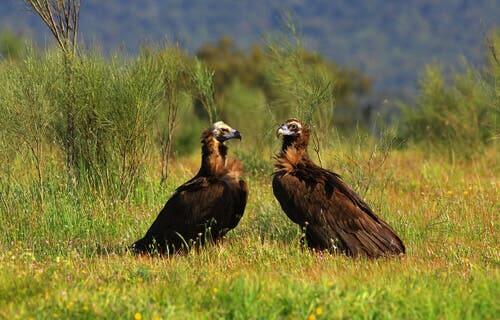Species of Vulture that Live in the Iberian Peninsula

There are several species of vulture in Spain, which makes this country one of the last refuges for carrion-eating birds in Europe. The vulture’s role in the ecosystem makes Spain necessary as a sanctuary for these birds. However, there are still are some serious threats that jeopardize this animal’s survival.
These birds’ contribution guarantees that our water can be drunk safely and are also part of the constant energy flow that occurs in ecosystems: without vultures, the breakdown of corpses is much slower and can lead to pollution and diseases.
There are four different species of vulture that live in Spain and all of them have an appearance that makes them unmistakable with other birds of prey. Up next, we’ll be covering them in detail.
Griffon vulture
Of all the vulture species in Spain, the griffon vulture (Gyps fulvus) (which is the featured image in this article) is the most abundant of them all. It’s characterized by having a chestnut-colored plumage and a featherless head and neck, which ends in a whitish plumage around it.
This particular morphology obeys the fact that this is the most specialized carrion-eating bird. It puts its head into the abdomen of large corpses, and this explains why its neck is featherless. This animal weighs up to 20 lbs and can exceed 8 feet in wingspan. In addition, and like most vultures, it has a very strong beak.
The griffon vulture lives in various parts of Europe, Africa, and Asia. It was on the brink of disappearance alongside other species in India, which caused a gigantic health crisis. This was due to the use of medicines for livestock that turned out to be toxic to this animal.
In Spain, it can be found in most mountains, except in some Mediterranean and coastal mountainous areas like Galicia. Nevertheless, this is a bird that travels long distances and it isn’t uncommon to see it in atypical places.
Egyptian Vulture
The Egyptian vulture (Neophron percnopterus) is the smallest of all species of vulture in Spain. Although it lives in large populations in Africa (and for some reason people call it Egyptian vulture), the truth is that the last of them that live in Europe survive in the Iberian Peninsula.

This bird is quite particular: its white plumage with some dark feathers contrasts with its yellow face, which merges with its beak in what looks like a kind of a mask. In addition, its ability to use tools is very surprising: it consumes carrion and bones, on which it will drop stones in order to break them and eat them.
Bearded vulture
Unlike the Griffon vulture, the population of Bearded vultures (Gypaetus barbatus) is much smaller, and, in Spain, there are only 100 specimens. Despite its small numbers, it remains the healthiest population of vultures in Europe, giving us an idea of the hunting these birds have been subject to in the West.

Its name comes from the way it gets its food. Some experts consider this fact another proof of how some animals are able to use tools. This bird also drops bones from great heights to break them and thus obtain the marrow.
Internationally, it isn’t a threatened species. Similar to the other vultures mentioned here, it’s difficult to mistake it with other carrion birds. Its wingspan is similar to the griffon’s, and its face has a mask that starts in its yellowish eyes. Its plumage has creamy-colored tones on the head and a great abundance of feathers that look like a beard, while its wings are black.
Cinereous vulture
The Cinereous vulture (Aegypius monachus) is the dark lord of European necrophages. It outperforms all of them in size, as it can have a wingspan of up to 10 feet long. It has black plumage, with some brown tones, while its bill is white with a black tip, and has a brown ruff.

Its population is less abundant than its relative the Griffon. Moreover, it hunts in lower-altitude rocks, allowing it to opt for smaller animal carrion such as rabbits. However, it’s also a traditional guest in areas with abundant dung.
In Europe, there are only 1,700 couples of Cinereous vulture. In addition, 80% of them are considered to be found in the Iberian Peninsula, especially in Monfragüe National Park. This area is considered to be the largest nesting area of this species on the planet.
What do you think of these majestic carrion-eaters? We hope you enjoyed learning about them today. Until next time!
